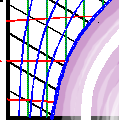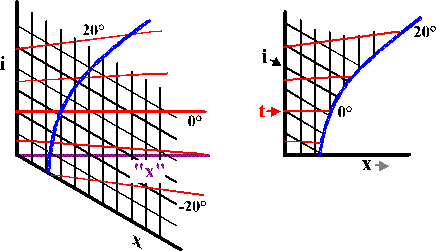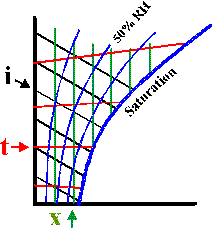
 |
The Mollier diagram - 2 |
The diagram shown at the end of part 1 shows no limit to the amount of water that can be evaporated into air. We know, however, that there is a limit, beyond which water can only exist as a fog of liquid water drops.
The water vapour concentration is expressed in the Mollier diagram as kg/kg of dry air. The concentration limit in these units is not fixed: it depends on the air pressure. The process of water vaporisation is, however, quite independent of air pressure. The equilibrium water vapour concentration over a water surface depends only on the temperature. This curious paradox can be explained by an example:
If the water surface is under two atmospheres of air pressure the water vapour concentration in kg per cubic metre will be exactly the same as in air at normal atmospheric pressure. The concentration of air in kilograms per cubic metre has, however, doubled. Therefore the concentration of water vapour per kilogram of air will be only half that in air at atmospheric pressure. The standard atmospheric pressure for the Mollier Diagram is 100.3 kiloPascal. I will return to the effect of air pressure in a later article: it causes some rather mysterious traces on dataloggers packed with art works into aircraft baggage compartments.
 The limit for the amount of water vapour in air increases ever more rapidly with temperature. The limit is shown as the blue curve on the diagram to the left. The region to the right of the curve cannot be reached in reality, so we can remove the lines in this region. Notice that the horizontal axis is still water vapour, x, even after shearing the diagram. We can therefore tidy up by removing the bottom of the diagram, so that it fills a rectangular page better.
The limit for the amount of water vapour in air increases ever more rapidly with temperature. The limit is shown as the blue curve on the diagram to the left. The region to the right of the curve cannot be reached in reality, so we can remove the lines in this region. Notice that the horizontal axis is still water vapour, x, even after shearing the diagram. We can therefore tidy up by removing the bottom of the diagram, so that it fills a rectangular page better.
 The only thing remaining to do is to embellish the left hand side of the diagram with lines which run at a constant distance ratio between the vertical axis and the heavy blue curve. These lines join points of equal relative humidity. Relative humidity is the water vapour concentration expressed as a percentage (or a fraction, to be pedantic) of the maximum possible water vapour concentration. 50%RH will therefore be represented by the line exactly half way between the vertical axis and the limiting water content.
The only thing remaining to do is to embellish the left hand side of the diagram with lines which run at a constant distance ratio between the vertical axis and the heavy blue curve. These lines join points of equal relative humidity. Relative humidity is the water vapour concentration expressed as a percentage (or a fraction, to be pedantic) of the maximum possible water vapour concentration. 50%RH will therefore be represented by the line exactly half way between the vertical axis and the limiting water content.
At this point the Central European reader can choose to stop, unless she uses Garry Thomson's book The Museum Environment as an essential reference. For her, and for Anglo American readers there is one further step:

This work is licensed under a Creative Commons Attribution-Noncommercial-No Derivative Works 3.0 License.